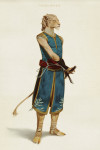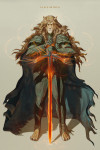Rick Wayne's Blog, page 32
December 5, 2019
(Fiction) The Knife That Killed Albert Gallagher Twice
We walked for hours through someone else’s dark and anxious dreams, and he navigated it as only a spiritwalker can, a man trained since birth not only to battle evil spirits but also to retrieve the lost souls of the sick. We emerged some time later in a church across the Adriatic, in a small town in the Alps above the city of Milan. We gave the parish priest quite a fright as we stepped from the gap in a marble ensconcement at the back of the sepulcher. The clock tower in the square outside made it clear we had covered not only distance but time. It was then several hours earlier than when we had left. He had done it intentionally—to give us a head start. It was odd, I told him, to think that right then, the two of us were also standing in the grand hall before the High Arcane. Could we not go and alter events, I asked, and he said no, that it was impossible to exit the shadow realm at any point whatsoever. He explained that no matter which path we took from the church—train, automobile, helicopter—we would not be able to reach the Keep of Solomon one moment before we left, and so the paradox was always avoided.
“Such is the nature of space and time,” he said.
An older gentleman, a head shorter than me with long sideburns and a derby hat, shuffled by and made a face at our clothes, and again at Etude’s bare feet.
“I have heard that time is also money,” I said. “Perhaps you could find a way to render it so.” I lifted the legs of my cotton pants. “We need new clothes. We look like cultists in these outfits.”
“Really?” He looked down at his shirt. “I rather liked them.”
We were in Bergamo, in the foothills of the Alps. Like most Italian towns, the three- and four-story buildings, all of a similar design, lined the cobbled streets on both sides without gaps, as if forming the walls of a maze whose paths were never straight. Every avenue bent slightly and at odd times seemingly for no reason other than to make sure you never quite knew where you were. It was a world unto itself and made to be so. It existed for the people who lived there. We found a quiet nook off a blind alley too narrow for cars to pass. There, after a brief meditation, Etude called upon the animals of the city, not just rats and pigeons but kestrels, blackbirds, red foxes, bright finches, mouse-sized bats, feral cats—even wall-climbing lizards and a handful of frogs who hopped out of gutters and from dark pipes that fell from the rooftops. He asked them if they knew of the shiny metals and bits of paper that the humans valued, and they said yes. He asked if they might bring them, and they agreed. They seemed quite eager, in fact, for no one had bothered to talk to them in a very, very long time.
A brown rat the size of a small dog was the first to reappear. It walked headfirst down a vertical drain pipe carrying something in its teeth. It dropped it on the ground near Etude’s bare feet. It was a silver ring, quite large and heavily tarnished, with swirling bands at the top that held in place a sapphire of at least ten karats. Etude bowed to the rat and introduced himself and me. The rat was a kind of wise man and he told my friend he had come as soon as he heard, for it was rare anymore for people to honor the old ways—the ways before cities and towns. He said that under this city many babies were starving, and Etude promised to knock over a rubbish bin near the river, which he did on our way out of town. The wise rat thanked him and left.
On and on it went. An animal appeared bearing a small treasure, something lost in the cracks and sewers, and asked an equally small favor of the shaman, which he happily obliged. Most of the requests were quite simple. A kestrel had some plastic netting wrapped around its feet and tail and asked that it be removed, which I was happy to do. She left us a single diamond earring. A mother cat with Gucci collar and name tag brought a snarling kitten, a child from a recent litter—a matted, angry little menace of a cub that her owners had discarded. The mother had rescued it and kept it in secret, but it bit her and refused to eat.
The young shaman wasted not a moment. He lifted the tiny terror by the scruff of its neck. It hissed and tried to bite him, but he merely moved his hands over it and spoke in a low voice. Even animals can be possessed, it seems. When the spirit was mesmerized, Etude passed his hand through the kitten’s body and brought it out in a closed fist. He whispered words to his fingers, then opened them and blew, and black ash scattered on the breeze. He returned the tiny kitten, now mewing plaintively to its mother, whose gave us her owner’s gold money clip, stuffed with neatly folded bills—so many, they could not be easily counted.
Before long, there was a line of animals stretching around the corner, and I felt like Etude and I were royalty, receiving gifts and entreaties from our noble subjects. We were polite to them, and they were polite to us. There was much bowing and speaking of ancient oaths. Soon, as word spread to the wilds that a true shaman had appeared in the city, all semblance of order was dropped. As their numbers grew, the animals took to frenzy, agitated to excitement by the mere chance to see the strange bald man who remembered the ancient treaties, when men and beasts had warred and become friends. Birds of all stripes and colors swooped into the alley and dropped prizes. Bullfrogs croaked and hopped laboriously forward amid a tangle of rats and mice and more than a few voles who scurried so quickly that it was very hard to see them. Each deposited before the feet of the shaman the shiny detritus of the city—metals and papers and strange cut rocks.
As the animals swarmed, the pile at Etude’s feet grew, and he raised his arms in thanks. And so he stood amid the chaos, hands high, like the barefoot conductor of a great pastoral symphony. And then, just like that, it was done. Etude brought his hands down and the animals scurried away in all directions, as if they forgot that they could speak and he could listen, and we were alone.
The pile we had amassed was nothing short of amazing. There were rings, bracelets, necklaces, loose gems and pearls, earrings, cash, and coins. Quite a bit of the jewelry was costume, of course, and amid the coins, I found several bottle caps, a penny slug, and some brass tokens to various laundromats and arcades. There was also a dog’s tag, three key chains (two with keys attached), and a ring fashioned from a nail. The birds had snagged a handful of restaurant receipts, presumably mistaking them for cash, including one bearing a freshly written phone number next to a hand-drawn heart. They had also pilfered someone’s grocery list and part of a newspaper crossword puzzle, all in Italian.
Even still, by the time the symphony reached it sudden climax, enough had been delivered to fill a small chest. It was a genuine treasure. I had never seen a treasure before. Etude knelt and thrust a hand into it and lifted a full fist. Gold fell from between his fingers and clinked on the cobblestones.
“Will this do?” he asked.
I nodded meekly.
It took us some time to gather and sort it all. The crown jewel was an emerald necklace that I was certain dated to the 17th century. There was also a casino chip worth ten million lire and a Roman-era coin that we would later sell for a sizable sum.
“This this looks old,” I said, raising another coin from the pile. I held it up.
It was about the size of a silver dollar and irregularly circular. The markings, as well as the faces that had been stamped onto both sides, were worn with age. Etude went pale when he saw it and cursed softly in his mother tongue, a language I rarely heard pass his lips.
It had been lost, we would discover, by an American GI during the liberation of Italy. His name was Albert Gallagher and he had wagered it in a card game against a fellow serviceman. Although no one knew it, Private Gallagher regularly cheated at cards using magic. In fact, he hadn’t lost a single game the entire war. Private Gallagher met his match, however, in a man from a different regiment, a mizzen from New Orleans named Paul Remi. Facing the prospect of losing everything, Private Gallagher played the penny. He was certain he couldn’t lose, for he knew there was no magic that could overturn it. But lose he did, to a seven-high straight, and after carrying that coin across the whole of North Africa and through seven near-death encounters, he watched it walk away in the pocket of the smiling Cajun, along with all his cash.
It was only later, after he was sober, that Private Gallagher realized the mizzen had cheated—but not with magic. Or at least, not only with magic. For Gallagher had also cheated with magic, which meant the mizzen had cheated with sleight of hand as well. He must have. There was no other explanation. Albert Gallagher was furious—furious that he had been beaten with parlor tricks, with the lowest form of false art, and when finally he found Corporal Remi, they quarreled and Private Gallagher was killed. He had already spent the Moirai penny, you see, and Fate makes no allowances for unfair play. In trying to take it back, to retrieve what he had spent, Gallagher’s luck reversed, and he slipped and fell on his own knife—the knife that killed him twice.
As it happened, the Albert Gallagher who died that day in Italy, the day the coin was ripped from a pocket and lost down a gutter, was not the real Albert Gallagher from Ames, Iowa. The real Private Gallagher, aged 20, had lost his parents and two brothers to various unfortunate circumstances, and when the war broke out, he felt that volunteering was the best way to honor their memory. However, before reporting for duty at an army base outside Mobile, Alabama, the young recruit thought he might see some of the country he was pledging his life to preserve. He hitched south and one night found himself playing a swell game of cards with some fellas in back of a service station. The men were smoking and drinking and shared stories of their lives. The young and inexperienced recruit let slip he was alone in the world—an innocent admission, but one that sealed his fate, for it meant there was no one alive who could identify him.
After the card game, Albert went to relieve himself by a tree, where one of the other players snuck up behind him and slit his throat with the knife. His body was buried in a bog, but not before his uniform and papers were taken. So it was the man who reported for duty in Mobile was not Albert Gallagher from Ames, Iowa, who knew nothing of magic, but one Wilbur Tuesday, aged 28, who was then wanted by the law in eight states.
To keep him safe in wartime, his teenage wife, Livonia, who loved the violent, reckless Wilbur as nothing else in the world, gave her husband a gift, something she had stolen from her mother. She gave her Wilbur a silver penny, which she had been instructed not to touch. She gave it to her husband along with similar instructions. He was never to spend that penny nor even let it fall from his person lest grave things happen. Of course, once Livonia’s mother, an old-timey witch from the hills of Tennessee, discovered it was missing, she had words with her daughter. The two fought, as mothers and daughters do—but also not as mothers and daughters do—and one of them wound up in the corn field.
Etude took the penny from my hands without a word.
rough cut from the fifth and final course of my full-course occult mystery, FEAST OF SHADOWS. Part One is available now. The epic urban fantasy concludes next year with Part Two.
cover image by Katherine Litveniko
December 4, 2019
(Art) The Twilight Forests of Ellie Davies
[image error]
“Forests have been shaped by human processes over thousands of years and include ancient woodlands, timber forestry, wildlife reserves, and protected areas. As such, the forest represents the confluence of nature, culture, and human activity. Forests are potent symbols in folklore, fairy tale, and myth — places of enchantment and magic as well as of danger and mystery. In more recent history, they have come to be associated with the psychology of the unconscious.
Our understanding of landscape can be seen as a construction in which layers of meaning that reflect our own cultural preoccupations and anxieties obscure the reality of the land, veiling it, and transforming the natural world into an idealisation.
Through a variety of temporary and non-invasive interventions in the forest, my work places the viewer in the gap between reality and fantasy, creating spaces which encourage the viewer to re-evaluate the way in which their own relationship with the landscape is formed, the extent to which it is a product of cultural heritage or personal experience.”




























December 2, 2019
(Fiction) To End All Prisons
Despite that many of them were Freemasons, a secret society steeped in the occult, the Founding Fathers envisioned an unspoiled continent, freed of old encumbrances—not just taxes but the arcane and complex practices that had for centuries determined the fate of nations. They deliberately enacted their rebellion without first seeking the advice of The Masters, of whom the Freemasons were vassals. Since they hadn’t asked, neither had they been expressly refused. Thus, when—against everyone’s expectations—the American Revolution was successful, the question naturally arose: what was to be done? But the High Arcane were not autocrats, even though they sometimes acted it. Except for the handful of matters where they took direct interest, their influence was intentionally oblique. They fancied themselves kingmakers rather than administrators and left the running of things to the men known to common history. As far as they were concerned, changes in government were inevitable, even healthy, and they neither desired nor sought formal ratifying power. At the same time, enterprises that threatened to upset the balance were always likely to bring their scrutiny, and so, if only from mere prudence, it was always better to seek their consultation in advance, where possible.
Here the Founders were shrewd. No sooner had fighting ceased than a secret delegation was dispatched. The Freemasons knew that The Masters had been pursuing their own grand enterprise for centuries, that they had been endeavoring to discover and seal the portals and doorways that dotted the earth, particularly at the intersection of its natural ley lines, whereby dark forces enter our plane. It had been understood since the discovery of the New World that the continents of North and South America would eventually need to brought under that enterprise, although given their size and antiquity, no one had yet contemplated how. Certain influential Americans vowed to support the project in return for assurances that the new government of the colonies would be left to run its own affairs. The Masters agreed, the first such scheme to be formalized in writing. The Louisiana Purchase of 1803 was orchestrated expressly for this purpose, and Lewis and Clark, with the help of a native shamaness, made the first serious attempt to map the ley lines of North America.
Under the terms of the understanding, which kept the United States formally separate from The Masters’ regime—whence came the Freemason’s motto, which predicted a “new world order”—the fledgling nation also couldn’t request support in matters arcane, which left America with a unique problem: how to police members of its growing magical community, many of whom had emigrated not to escape persecution but justice. Catching them was difficult enough. Holding them proved almost impossible.
A crisis was reached in 1804 when, after one such failed apprehension, the city of Detroit was burned to the ground. A secret meeting was called by then-President Jefferson and proposals were solicited for a final solution. It would be a full two years before a winner was selected and another three before the necessary funds were raised, for in typical American fashion, the structure to be built was unlike anything that had been attempted before. Not just a prison. A prison to end all prisons.
Rather than a tower, which stretched the energies necessary to defend it, the centerpiece of the winning proposal, submitted by architect Jeremiah Everly and magus Zachary Xavier Thorne, was a star fort, then a common method of military fortification. Originally designed to repel magical attack—by turning a castle into a giant binding hexagram—star forts were also effective against cannon shot. Everly and Thorne’s genius was to invert the hex, to turn the binding inward, to keep people in rather than keep them out.
A remote island was selected in the bayous of Louisiana, far removed from any magical influence, and in the spring of 1809, ground was finally broken. Construction was beset by delays, including the War of 1812, and took a further thirteen years. When the doors were finally opened in 1822, it was without ceremony, for by then, the project had taken the lives of three women and thirty-seven men, including the founders. Mr. Thorne died in a smelting accident. A casing exploded and plated the man from head to toe in sterling silver. Two years later, the brooding Mr. Everly succumbed to melancholia when bog water inexplicably flooded the foundation for the third time and he threw himself in. In honor of the men, the project once destined to be called Black Water Penal Colony was instead humbly ordained Everly-Thorne Penitentiary. But it was a hulking place, remote and dire, and none of the inmates ever called it that, nor too the guards and wardens who lived in the fort for months at a time. Forty years later, at the outset of the Civil War, when management of the facility was transferred to a private consortium under the direction of The Masters, its true name was officially recognized—Everthorn Prison.
It was the Civil War that ended the Founding Fathers’ dream of a continent free of the influence of old world magic. From the beginning, the native shamans had resisted—sometimes violently—the sealing of the doors and portals through which they summoned their ancestors and healing spirits, and despite that the American ruling elite had no material interest in The Masters’ long-term enterprise, it chose to ally against the shamans out of expediency. Advisers close to President Andrew Jackson secured his approval to invite members of the High Arcane’s secret apparatus—agents and provocateurs—to help break the shamanic resistance in the West in return for certain additional concessions that kept a permanent arcane presence on the continent. The bulk of the New World’s magic users had settled in the south, for various reasons, and after the outbreak of civil war, the largely industrial Union found it had no adequate response to the Confederacy’s occult army. Lincoln’s government had no choice but to scrap the document of understanding and ask for aid, and slowly but surely over the next hundred years, The Masters asserted their influence over the whole of the Americas.
The first concession requested by the Old World powers was use of the remote star fort on a small island in the bayou, which, over the subsequent decades, became home to countless madmen, magicians, illusionists, warlocks, and witches from all over the world. The reason they came, some from as far as Tibet, was the same reason they never left. Everly and Thorne’s ingenious design included a pair of massive enchanted boundaries: the Rings True. The outer boundary, made of pure silver, was only seven centimeters thick but ran nearly three miles in circumference. Cast in one single piece—the largest casting in human history—it took four years to produce and required new smelting techniques and several dozen attempts before a single flawless ring was produced without joints or welds. The inner barrier, made predominantly of iron, was poured around a core of pure selenium, a metal previously known only to the alchemists. This second ring was smaller than the first but also much thicker such that it used the same total volume of metal and resonance was achieved between the rings, amplifying their power.
To reach the hexagonal fort at the center, or to escape it, the Rings True had to be pivoted—down in the case of the outer ring, up in the case of the inner. To preserve a continuous barrier, only one ring was tilted at a time. The energy required to move each ring, plus its brick encasement, had necessitated the construction of another novelty, a massive geared dynamo called the Prime Mover, which was half-buried between the two rings and thus protected from attack on both sides. The gear box for the Mover, the two-story volcanic obsidian hemisphere that encased the device, was bounded on the interior by a black salt moat such that no spirits could be sent to interfere with its workings and so facilitate an escape for anyone inside, making the prison a universe to itself, hermetically sealed. Indeed, from the air, it resembled a solar diagram, or perhaps the atomic structure of hydrogen, with a black moon between two rings, orbiting at a distance from a white six-pointed sun.
The cost and complexity of the construction meant that nothing like it was ever attempted again. Nor was there was ever a need. In two hundred years of use, the inmates took control of the fort on three occasions, once for a period of 17 weeks, but not one ever escaped.
rough cut from the fifth and final course of my full-course occult mystery, FEAST OF SHADOWS. Part One is available now. The epic urban fantasy concludes next year with Part Two.
December 1, 2019
(Feature) AI and the future of humanity
Whether we like it or not, Algorithmic Intelligence is here to stay, and genuine Artificial Intelligence, even though not related, is probably coming at some point in the future. Just like genetic modification of food and humans, you couldn’t stop either if you wanted to. And to be fair, they genuinely have the potential to make life better for everybody.
[EDIT: How and why was covered excellently in a recent FRONTLINE documentary.]
The challenge is that there’s not going to be a straight line from here to there, and history suggests things will probably get worse — potentially, A LOT worse — before the benefits of AI outweigh the costs. Because there will be costs.
To be clear, I’m not a pessimist by disposition. I believe problems in life and in history are both inevitable and solvable, which means we shouldn’t fret unnecessarily when a new one appears. But a little worry goes a long way.
First, consider the typical course:
A new invention or discovery, often by a young person who has more intelligence than wisdom, promises to make life better for all mankind.
Optimists, typically liberals, foresee what we can do with it and assume therefore we will and so welcome it uncritically.
We do some good, but also a lot of bad — much of it completely unanticipated. (For example, the internet facilitates commentary like this, but measured by weight it’s mostly porn. By far. After that, it’s gambling, cat pictures, selfies, scams, misinformation, and organized crime, both private and public.)
The invention improves the condition of elites, typically by making things a little worse for everyone else, and the novelty is soberly re-examined for what it really is versus what we wanted it to be. (We’re at this stage now with social media/big data.)
The government gets involved. Bans and prohibitions are enacted, addressing symptom rather than cause.
The wealthy and politically connected quickly claim beneficial exceptions, often in isolated “walled gardens” separate from the rest of us.
Generations of inequality and/or outright suffering follow, such as after the invention of the steam engine, which made products more affordable for everyone but also ripped limbs from children and stagnated wages for nine decades.
Some time later, people start to contemplate the responsible governance they should’ve considered at the point of irrational exuberance.
Changes are introduced gradually over the constant objection of political conservatives, and slowly, mostly by trial and error, life gradually improves for everyone but the poor, who are pretty much ignored by Right and Left alike.
Futurists in the 1930s predicted that after the invention of a robotic labor force, men would no longer need to work. Their erroneous assumption was that resources would be shared rather collected at the top.
And in fact they used to be. From the advent of the labor union to its decline in the 1980s, workers tended to share in the success of the firm. That is, if the company did better, everybody did better. Bosses took more, but if they got a raise, so did the line.
The productivity gained from information technology was not shared. Office workers never unionized, and so while productivity has skyrocketed since 1980, growing by 70%, real wages have only grown about 9%. Bosses took the rest, which is why wealth inequality reversed and has been steadily climbing since the Reagan/Thatcher era.
[image error]
AI might eventually reach such ubiquity that the futurist’s predictions in the 1930s will come to pass and all (or almost all) humans will benefit from it. That’s definitely possible.
If you’re an optimist, consider a thought experiment. Imagine you have traveled back in time to the year 1910 and are sitting in a parlor with a group of intellectuals who believe you are from the future, and they lean in with bright eyes and ask you: How will life be for us?
What do you say?
“In a few years, there will be a horrible global war that will kill unprecedented numbers of people, not just through violence but also famine and disease. After that, you will suffer a horrible influenza epidemic second only to the Black Death, followed in a decade by a massive and unprecedented economic depression that will put millions out of work and displace millions more. Many will die.
“The economy will eventually recover, but only because of another world war, this one even larger and more devastating than the first (if you can believe it), and which will see the invention and use of weapons capable of wiping out the entire human race. In the aftermath, the European colonial empires will retract, leaving a vacuum of power, and the developing world, from South America to Africa to Asia, will experience repeated waves of socialist revolution, genocide, and famine .
“But… for those who survive, things will actually get better than ever before. Literacy and life expectancy will increase. Democracy will spread. Global poverty will plummet. Basic social safety nets will be introduced, including national health insurance and a minimum wage. Women will get the vote and racial integration will be the law of the land, if not always the practice. So chin up! Smile on your faces!”
I think the greatest myth we were sold after the end of the Cold War was that history had stopped, that it was just going to be liberal democracy as far as the eye could see. It certainly seemed that way after the Wall fell, followed quickly by the Soviet Union.
But those of us alive today are the beneficiaries of history, not its victims, making that myth probably the greatest survivorship bias in recent history.
The Tienanmen Square protests, which failed to introduce change, took place the same year the Wall came down, but the China of 1989 was almost an economic afterthought, especially compared to Japan, who seemed poised to conquer the world. There was no sense that China would ever accomplish anything, except by great weight, and that eventually, she too would have to join the New World Order.
In a single generation, China has become the world’s largest economy and a committed leader in AI research. Two of the five fastest computers in the world are there, with more on the way. China’s leaders are building a surveillance state the likes of which the world has never seen.
In the same period, the “Arab Spring” failed to produce any lasting change, and the number of democracies has started to decline for the first time in history. The greatest wave of transnational immigration ever has sparked the return of fascism as a serious political force, and, thanks to the telecommunications revolution, propaganda has grown while personal privacy has all but disappeared.
In other words, the world is tumbling back towards political chaos at the same time that widespread climate change will shift the global distribution of water.
To this, we will add AI.
[EDIT: For a fantastic summary of the challenges it will bring and why, see this 2018 Atlantic article by historian and scholar Yuval Noah Harari. There is no need for me to summarize it here.]
For me, the problem with AI isn’t just that it introduces another social asymmetry, such as what we’ve seen before going all the way back to the invention of agriculture, but that it introduces the ultimate asymmetry.
In the past, the wealthy and powerful were always — at some point, once you got far enough down — dependent on the poor and working classes: to grow food, to staff factories, to fill armies, to clean house, etc. That meant there was a floor to human suffering. Things could only get so bad before workers went on strike or the population rebelled and so introduced a “correction” (in economic terms). This is the fodder of history, the dates of which you were forced to memorize in school.
AI — by which I mean all of it, both today’s algorithmic intelligence and tomorrow’s true artificial consciousness — has the genuine potential to render the great mass of people not just superfluous but an outright burden. There will be no reason, in a politico-economic sense, for most of them to exist since neither their labor nor their vote will empower the ruling class.
As the experts point out, it isn’t that machines will take over and humanity will serve them. It’s that they will become the tools by which most of humanity serves a fraction of it.
And if we rebel? When AI produces the food, manufactures the goods, and comprises the military, there will no longer be anything to stop the powers-that-be from reproducing and extending the “solutions” that have repeatedly occurred throughout human history: from Stalinist Russia to the pogroms of medieval Europe to the Khmer Rouge to the Rwandan genocide and on and on, right up to what’s going on in Myanmar at the time I’m writing this.
Wherever we go, there we are. With whatever tools we invent, the hand that holds them is still a human one.
If we accept the simple premise that history is not done, is likely never done, we must also accept that, sooner or later, another calamity will occur, which means we are living through an interregnum period.
Almost all of the great calamities of the modern era have followed large-scale technological-economic change.
So let’s complete our thought experiment. Imagine a traveler from the year 2110 is sitting in your living room. You lean in bright-eyed and ask him: How will life be for us?
November 29, 2019
Mystery, Babylon
[image error]
17:1 And there came one of the seven angels which had the seven vials, and talked with me, saying unto me, Come hither; I will shew unto thee the judgment of the great whore that sitteth upon many waters:
17:2 With whom the kings of the earth have committed fornication, and the inhabitants of the earth have been made drunk with the wine of her fornication. [“Fornication” is interpreted or translated as “idolatry” in the Amplified Bible (AMP)]
17:3 So he carried me away in the spirit into the wilderness: and I saw a woman sit upon a scarlet coloured beast, full of names of blasphemy, having seven heads and ten horns.
17:4 And the woman was arrayed in purple and scarlet colour, and decked with gold and precious stones and pearls, having a golden cup in her hand full of abominations and filthiness of her fornication:
17:5 And upon her forehead was a name written, MYSTERY, BABYLON THE GREAT, THE MOTHER OF HARLOTS AND ABOMINATIONS OF THE EARTH. [King James Version; the New International Version uses “prostitutes” instead of “harlots”. The King James Version and New King James Version include the word ‘mystery’ within her title, but in many other English translations the word is descriptive of the name: “a name that has a secret meaning” – Good News Bible].
17:6 And I saw the woman drunken with the blood of the saints, and with the blood of the martyrs of Jesus: and when I saw her, I wondered with great admiration.
17:9 And here is the mind which hath wisdom. The seven heads are seven mountains, on which the woman sitteth.
17:10 And there are seven kings: five are fallen, and one is, and the other is not yet come; and when he comes, he must continue a short space.
17:11 And the beast that was, and is not, even he is the eighth, and is of the seven, and goes into perdition.
17:12 And the ten horns which thou saw are ten kings, which have received no kingdom as yet; but receive power as kings one hour with the beast.
17:15 And he said unto me, The waters which thou sawest, where the whore sitteth, are peoples, and multitudes, and nations, and tongues.
17:18 And the woman which thou sawest is that great city, which reigns over the kings of the earth.
— Revelation 17:1–18
November 27, 2019
(Art) The Lonely Death Dioramas of Miyu Kojima
[image error]
One diorama at a time, miniaturist reconstructs aftermaths of ‘lonely deaths’
Inside a grimy six-tatami room lies a darkly stained blanket — an ominous reminder of its owner, and his demise.
Scattered on a circular chabu-dai coffee table are empty jars of “one-cup” sake and shōchū (distilled spirits), the moldy remains of a convenience store bento-box lunch and horse-racing stubs — hints that the inhabitant may have met his sudden, solitary death while contemplating his chances at the racetrack.
In another room, a blue tarp holding a pool of blood is spread out below a severed noose tied to a ladder leading up to the loft. On the wall, written in tape, is the word “gomen” (“sorry”), while what appears to be a last will sits on the desk.
Then there’s the bathroom. Here, a red soupy liquid fills the bathtub, its contents unknown, and overflows onto the tiled floor.
This isn’t a walk-through of a horror house or a set of crime-scene photos. These dark scenes are miniature replicas, dioramas of real rooms where occupants have died, recreated with eerily realistic details by Miyu Kojima.
[image error]
“Each room has its own story and reflects what I’ve seen in my line of work,” says Kojima, a 27-year-old employee of ToDo-Company, a firm that specializes in cleaning up homes with morbid pasts. Her jobs often involve cleaning up after what is known as kodokushi — “lonely deaths” — where those living alone are found dead in their homes, sometimes going unnoticed for days or even weeks.
In Tokyo, 4,777 people died alone in 2017, according to the Bureau of Social Welfare and Public Health. Around a third were found two to three days after their death, while nearly 10 percent were discovered more than a month after they passed away. Meanwhile the number of one-person households in Japan soared to 18.42 million in 2015 from 16.78 million in 2010 and is expected to reach 40 percent of all households by 2040, according to government forecasts.
Kojima first began making her intricate dioramas several years ago, when she created some for a funeral industry trade show that her company participated in. Rather than showcasing “before” photographs of rooms the company had cleaned — which, she says can be too graphic for the squeamish — she thought presenting them as three-dimensional models would convey the gruesome nature of the phenomenon in a more sensitive light.
Attendees to the company booth, surprised by the miniature rooms, took photos of her models and began sharing the images on social media. Kojima soon found herself being interviewed about her work and kodokushi, a widely reported symptom of Japan’s graying, shrinking population that has led to a surge in single-person households. In August, she published “Toki ga Tomatta Heya” (“Rooms Where Time Has Stopped,” a book chronicling her experience as a special kind of apartment cleaner.
[image error]
The labor-intensive job isn’t for the faint-of-heart. The stench wafting from the rooms can be overpowering during Japan’s humid summers, while insects often greet the cleaners who all wear protective gear.
A typical day will involve cleaning and clearing rooms for around five to six hours straight, while also sorting through the furniture and belongings of the deceased to determine what goes and what stays. It may be far from a glorious profession but, for Kojima, it was a calling.
Kojima’s father was an excessive drinker, a habit that cost him his job and family. He was living separately when Kojima’s mother, divorce papers in hand, visited him to drive the final nail into their relationship. Instead, she found her husband lying on the floor, unconscious from a stroke.
Kojima, then 17, was able to visit her father at the hospital before he took his final breath, but still wonders what would have happened if her mother hadn’t dropped by his home that day.
“He could have been a kodokushi victim,” she says.
The incident led her to empathize with families who have lost their kin in similar ways. When she was 22, she joined ToDo-Company and became its sole female staff.
Kojima vividly recalls the first time she cleaned a room that was the site of a lonely death. It was late summer and the crew at her company were summoned to an apartment on the second floor of a building, right above a supermarket.
“I could smell it before even setting my foot on the staircase leading up to the room,” she recalls. “And when we reached the entrance to the apartment, I could see cockroaches wriggling in the narrow space under the door.”
The man’s body had already been hauled away, but maggots crawled in the space where he had been lying for several months. Despite being a tiny room equipped with a bathroom, there were plastic bottles filled with urine. Coins were neatly lined up as if the owner was counting off the days on a calendar.
“After we cleaned the room, we invited a monk to purify the property. When everyone was gone and I was left alone, I mumbled a short prayer wishing the person could go to heaven,” Kojima says. “At that moment, something brushed against the back of my neck, and I felt it was a sign that my prayer was heard.”
[image error]
Of the models Kojima creates, she says that rather than replicating specific rooms in precise detail, she tries “to capture the essence of the characteristics that I noticed while cleaning them out.”
She also assembles models of another kind of cleaning job — the clearing out of so-called gomiyashiki (“trash houses”), homes cluttered with unnecessary junk and garbage. Clients, she says, are frequently embarrassed owners pretending to make a request on behalf of a family member or friend.
Again, painstaking detail goes into re-creating such rooms: crumpled pages from newspapers, boxes of Domino’s Pizza and Cup Noodle containers dot a roach-infested floor of one miniature room also littered with garbage bags and cardboard boxes.
Everything is made from scratch, Kojima says, and it takes around three months for her to create three rooms. For her next project, she plans to introduce a different medium into her creations — something to also celebrate the lives of those who have died in the rooms that she helps clean.
“I’m thinking of projecting 3D images of people moving in my models to show that despite the way they may have died, these people all led regular lives,” she says.


















November 26, 2019
(Art) The Animorphic Camelot of Justin Cherry
November 25, 2019
I had a dream based on the painting “In the Pavilion of ...
[image error]
I had a dream based on the painting “In the Pavilion of the Red Clown” by Robert Williams.
I was in a demented circus pitched in a field. There was no sense that there was anything outside the circus, which was peopled by both performers and visitors, although the visitors never left.
The circus was ruled by the clowns, each of whom held dominion over some territory. (There was a Ringmaster, but he was a mere puppet.) The most powerful were the Red Clown and the Yellow Clown, both of whom were bloodthirsty and vicious.
I never saw the remaining Blue and Green Clowns, but I had the sense that their territories were much smaller, and that they were more capricious than vicious.
I had bartered with the Red Clown, which was considered quite dangerous. In return for completing some task, which appeared innocent but which I knew was not, the Red Clown had promised to give me something I desperately wanted.
That’s all I remember.
November 24, 2019
(Fiction) Borges’ The Theologians
I’m not in the habit of interpreting literature for others. As a rule, I can only mislead — or else rob you of a moment of profound insight.
However, only very bad rules have no exceptions.
Borges’ delicious short story about a pair of warring theologians in the ancient world might seem to be as far from modern society, as far from relevance, as possible. But I submit to you that the following tale of murder by orthodoxy is replayed on Twitter every day.
These days, we ‘cancel’ people rather than burn them, but the raw human psychology is the same, which is of course what makes this a work of art — on my definition: a lie that reveals the truth. It touches on something profound, especially when you consider that the Christian church, here the persecutor, was itself the persecuted a few generations before.
In other words, the content of our beliefs seems to matter very little. Hence Borges’ last line.
The Theologians by Jorge Luis Borges
After having razed the garden and profaned the chalices and altars, the Huns entered the monastery library on horseback and trampled the incomprehensible books and vituperated and burned them, perhaps fearful that the letters concealed blasphemies against their god, which was an iron scimitar. Palimpsests and codices were consumed, but in the heart of the fire, amid the ashes, there remained almost intact the twelfth book of the Civitas Dei, which relates how in Athens Plato taught that, at the centuries’ end, all things will recover their previous state and he in Athens, before the same audience, will teach this same doctrine anew. The text pardoned by the flames enjoyed special veneration and those who read and reread it in that remote province came to forget that the author had only stated this doctrine in order better to refute it. A century later, Aurelian, coadjutor of Aquileia, learned that on the shores of the Danube the very recent sect of the Monotones (called also the Annulars) professed that history is a circle and that there is nothing which has not been and will not be. In the mountains, the Wheel and the Serpent had displaced the Cross. All were afraid, but all were comforted by the rumor that John of Pannonia, who had distinguished himself with a treatise on the seventh attribute of God, was going to impugn such an abominable heresy.
Aurelian deplored this news, particularly the latter part. He knew that in questions of theology there is no novelty without risk; then he reflected that the thesis of a circular time was too different, too astounding, for the risk to be serious. (The heresies we should fear are those which can be confused with orthodoxy.) John of Pannonia’s intervention –his intrusion –pained him more. Two years before, with his verbose De septima affectione Dei sive de aeternitate, he had usurped a topic in Aurelian’s speciality; now, as if the problem of time belonged to him, he was going to rectify the Annulars, perhaps with Procrustean arguments, with theriacas more fearful than the Serpent. . . That night, Aurelian turned the pages of Plutarch’s ancient dialogue on the cessation of the oracles; in the twenty-ninth paragraph he read a satire against the Stoics, who defend an infinite cycle of worlds, with infinite suns, moons, Apollos, Dianas and Poseidons. The discovery seemed to him a favorable omen; he resolved to anticipate John of Pannonia and refute the heretics of the Wheel.
There are those who seek a woman’s love in order to forget her, to think no more of her; Aurelian, in a similar fashion, wanted to surpass John of Pannonia in order to be rid of the resentment he inspired in him, not in order to harm him. Tempered by mere diligence, by the fabrication of syllogisms and the invention of insults, by the negos and autems and nequaquams, he managed to forget that rancor. He erected vast and almost inextricable periods encumbered with parentheses, in which negligence and solecism seemed as forms of scorn. He made an instrument of cacophony. He foresaw that John would fulminate the Annulars with prophetic gravity; so as not to coincide with him, he chose mockery as his weapon. Augustine had written that Jesus is the straight path that saves us from the circular labyrinth followed by the impious; these Aurelian, laboriously trivial, compared with Ixion, with the liver of Prometheus, with Sisyphus, with the king of Thebes who saw two suns, with stuttering, with parrots, with mirrors, with echoes, with the mules of a noria and with two-horned syllogisms. (Here the heathen fables survived, relegated to the status of adornments.) Like all those possessing a library, Aurelian was aware that he was guilty of not knowing his in its entirety; this controversy enabled him to fulfill his obligations with many books which seemed to reproach him for his neglect. Thus he was able to insert a passage from Origen’s work De principiis, where it is denied that Judas Iscariot will again betray the Lord and that Paul will again witness Stephen’s martyrdom in Jerusalem, and another from Cicero’s Academica priora, where the author scoffs at those who imagine that, while he converses with Lucullus, other Luculluses and Ciceros in infinite number say precisely the same thing in an infinite number of equal worlds. In addition, he wielded against the Monotones the text from Plutarch and denounced the scandalousness of an idolater’s valuing the lumen naturae more than they did the word of God. The writing took him nine days; on the tenth, he was sent a transcript of John of Pannonia’s refutation.
It was almost derisively brief; Aurelian looked at it with disdain and then with fear. The first part was a gloss on the end verses of the ninth chapter of the Epistle to the Hebrews, where it is said that Jesus was not sacrificed many times since the beginning of the world, but now, once, in the consummation of the centuries. The second part adduced the biblical precept concerning the vain repetitions of the pagans (Matthew 6:7) and the passage from the seventh book of Pliny which ponders that in the wide universe there are no two faces alike. John of Pannonia declared that neither are there two like souls and that the vilest sinner is as precious as the blood Jesus shed for him. One man’s act (he affirmed) is worth more than the nine concentric heavens and imagining that this act can be lost and return again is a pompous frivolity. Time does not remake what we lose; eternity saves it for heaven and also for hell. The treatise was limpid, universal; it seemed not to have been written by a concrete person, but by any man or, perhaps, by all men.
Aurelian felt an almost physical humiliation. He thought of destroying or reforming his own work; then, with resentful integrity, he sent it to Rome without modifying a letter. Months later, when the council of Pergamum convened, the theologian entrusted with impugning the Monotones’ errors was (predictably) John of Pannonia; his learned and measured refutation was sufficient to have Euphorbus the heresiarch condemned to the stake. “This has happened and will happen again,” said Euphorbus. “You are not lighting a pyre, you are lighting a labyrinth of flames. If all the fires I have been were gathered together here, they would not fit on earth and the angels would be blinded. I have said this many times.” Then he cried out, because the flames had reached him.
The Wheel fell before the Cross (* In the Runic crosses the two contrary emblems coexist entwined), but Aurelian and John of Pannonia continued their secret battle. Both served in the same army, coveted the same guerdon, warred against the same Enemy, but Aurelian did not write a word which secretly did not strive to surpass John. Their duel was an invisible one; if the copious indices do not deceive me, the name of the other does not figure once in the many volumes by Aurelian preserved in Migne’s Patrology. (Of John’s works only twenty words have survived.) Both condemned the anathemas of the second council of Constantinople; both persecuted the Arrianists, who denied the eternal generation of the Son; both testified to the orthodoxy of Cosmas’ Topographia Christiana, which teaches that the earth is quadrangular, like the Hebrew tabernacle. Unfortunately, to the four corners of the earth another tempestuous heresy spread. Originating in Egypt or in Asia (for the testimonies differ and Bousset will not admit Harnack’s reasoning), it infested the eastern provinces and erected sanctuaries in Macedonia, in Carthage and in Treves. It seemed to be everywhere; it was said that in the diocese of Britannia the crucifixes had been inverted and that in Caesarea the image of the Lord had been replaced by a mirror. The mirror and the obolus were the new schismatics’ emblems.
History knows them by many names (Speculars, Abysmals, Cainites), but the most common of all is Histriones, a name Aurelian gave them and which they insolently adopted. In Frigia they were called Simulacra, and also in Dardania. John of Damascus called them Forms; it is well to note that the passage has been rejected by Erfjord. There is no heresiologist who does not relate with stupor their wild customs. Many Histriones professed asceticism; some mutilated themselves, as did Origen; others lived underground in the sewers; others tore out their eyes; others (the Nabucodonosors of Nitria) “grazed like oxen and their hair grew like an eagle’s.” They often went from mortification and severity to crime; some communities tolerated thievery; others, homicide; others, sodomy, incest and bestiality. All were blasphemous; they cursed not only the Christian God but also the arcane divinities of their own pantheon. They contrived sacred books whose disappearance is lamented by scholars. In the year 1658, Sir Thomas Browne wrote: “Time has annihilated the ambitious Histrionic gospels, not the Insults with which their Impiety was fustigated”: Erfjord has suggested that these “insults” (preserved in a Greek codex) are the lost gospels. This is incomprehensible if we do not know the Histriones’ cosmology.
In the hermetic books it is written that what is down below is equal to what is on high, and what is on high is equal to what is down below; in the Zohar, that the higher world is a reflection of the lower. The Histriones founded their doctrine on a perversion of this idea. They invoked Matthew 6:12 (“and forgive us our debts, as we forgive our debtors”) and 11:12 (“the kingdom of heaven suffereth violence”) to demonstrate that the earth influences heaven, and I Corinthians 13:12 (“for now we see through a glass, darkly”) to demonstrate that everything we see is false. Perhaps contaminated by the Monotones, they imagined that all men are two men and that the real one is the other, the one in heaven. They also imagined that our acts project an inverted reflection, in such a way that if we are awake, the other sleeps, if we fornicate, the other is chaste, if we steal, the other is generous. When we die, we shall join this other and be him. (Some echo of these doctrines persisted in Léon Bloy.) Other Histriones reasoned that the world would end when the number of its possibilities was exhausted; since there can be no repetitions, the righteous should eliminate (commit) the most infamous acts, so that these will not soil the future and will hasten the coming of the kingdom of Jesus. This article was negated by other sects, who held that the history of the world should be fulfilled in every man. Most, like Pythagoras, will have to transmigrate through many bodies before attaining their liberation; some,the Proteans, “in the period of one lifetime are lions, dragons, boars, water and a tree.” Demosthenes tells how the initiates into the Orphic mysteries were submitted to purification with mud; the Proteans, analogously, sought purification through evil. They knew, as did Carpocrates, that no one will be released from prison until he has paid the last obolus (Luke 12:59) and used to deceive penitents with this other verse: “I am come that they might have life, and that they might have it more abundantly” (John 10:10). They also said that not to be evil is a satanic arrogance. . . Many and divergent mythologies were devised by the Histriones; some preached asceticism, others licentiousness. All preached confusion. Theopompus, a Histrione of Berenice, denied all fables; he said that every man is an organ put forth by the divinity in order to perceive the world.
The heretics of Aurelian’s diocese were of those who affirmed that time does not tolerate repetitions, not of those who affirmed that every act is reflected in heaven. This circumstance was strange; in a report to the authorities in Rome, Aurelian mentioned it. The prelate who was to receive the report was the empress’ confessor; everyone knew that this demanding post kept him from the intimate delights of speculative theology. His secretary — a former collaborator of John of Pannonia, now hostile to him — enjoyed fame as a punctual inquisitor of heterodoxies; Aurelian added an exposition of the Histrionic heresy, just as it was found in the conventicles of Genua and of Aquileia. He composed a few paragraphs; when he tried to write the atrocious thesis that there are no two moments alike, his pen halted. He could not find the necessary formula; the admonitions of this new doctrine (“Do you want to see what human eyes have never seen? Look at the moon. Do you want to hear what ears have never heard? Listen to the bird’s cry. Do you want to touch what hands have never touched? Touch the earth. Verily I say that God is about to create the world.”) were much too affected and metaphorical to be transcribed. Suddenly, a sentence of twenty words came to his mind. He wrote it down, joyfully; immediately afterwards, he was troubled by the suspicion that it was the work of another. The following day, he remembered that he had read it many years before in the Adversus annulares composed by John of Pannonia. He verified the quotation; there it was. He was tormented by incertitude. If he changed or suppressed those words he would weaken the expression; if he left them he would be plagiarizing a man he abhorred; if he indicated their source, he would be denouncing him. He implored divine assistance. Towards the beginning of the second twilight, his guardian angel dictated to him an intermediate solution. Aurelian kept the words, but preceded them with this notice: “What the heresiarchs now bark in confusion of the faith was said in our realm by a most learned man, with more frivolity than guilt.” Then the dreaded, hoped for, inevitable thing happened. Aurelian had to declare who the man was; John of Pannonia was accused of professing heretical opinions.
Four months later, a blacksmith of Aventinus, deluded by the Histriones’ deceptions, placed a huge iron sphere on the shoulders of his small son, so that his double might fly. The boy died; the horror engendered by this crime obliged John’s judges to assume an unexceptionable severity. He would not retract; he repeated that if he negated his proposition he would fall into the pestilential heresy of the Monotones. He did not understand (did not want to understand) that to speak of the Monotones was to speak of the already forgotten. With somewhat senile insistence, he abundantly gave forth with the most brilliant periods of his former polemics; the judges did not even hear what had once enraptured them. Instead of trying to cleanse himself of the slightest blemish of Histrionism, he strove to demonstrate that the proposition of which he was accused was rigorously orthodox. He argued with the men on whose judgment his fate depended and committed the extreme ineptitude of doing so with wit and irony. On the 26th of October, after a discussion lasting three days and three nights, he was sentenced to die at the stake.
Aurelian witnessed the execution, for refusing to do so meant confessing his own guilt. The place for the ceremony was a hill, on whose green top there was a pole driven deep into the ground, surrounded by many bundles of wood. A bailiff read the tribunal’s sentence. Under the noonday sun, John of Pannonia lay with his face in the dust, howling like an animal. He clawed the ground but the executioners pulled him away, stripped him naked and finally tied him to the stake. On his head they placed a straw crown dipped in sulphur; at his side, a copy of the pestilential Adversus annulares. It had rained the night before and the wood burned badly. John of Pannonia prayed in Greek and then in an unknown language. The fire was about to engulf him when Aurelian finally dared to raise his eyes. The bursts of flame halted; Aurelian saw for the first and last time the face of the hated heretic. It reminded him of someone, but he could not remember who. Then he was lost in the flames; then he cried out and it was as if a fire had cried out. Plutarch has related that Julius Caesar wept for the death of Pompey; Aurelian did not weep for the death of John, but he felt what a man would feel when rid of an incurable disease that had become a part of his life. In Aquileia, in Ephesus, in Macedonia, he let the years pass over him. He sought the arduous limits of the Empire, the torpid swamps and contemplative deserts, so that solitude might help him understand his destiny. In a cell in Mauretania, in a night laden with lions, he reconsidered the complex accusation brought against John of Pannonia and justified, for the nth time, the sentence. It was much more difficult to justify his own tortuous denunciation. In Rusaddir he preached the anachronistic sermon “Light of lights burning in the flesh of a reprobate.” In Hibernia, in one of the hovels of a monastery surrounded by the forest, he was startled one night towards dawn by the sound of rain. He remembered a night in Rome when that minute noise had also startled him. At midday, a lightning bolt set fire to the trees and Aurelian died just as John had.
The end of this story can only be related in metaphors since it takes place in the kingdom of heaven, where there is no time. Perhaps it would be correct to say that Aurelian spoke with God and that He was so little interested in religious differences that He took him for John of Pannonia. This, however, would imply a confusion in the divine mind. It is more correct to say that in Paradise, Aurelian learned that, for the unfathomable divinity, he and John of Pannonia (the orthodox believer and the heretic, the abhorrer and the abhorred, the accuser and the accused) formed one single person.
November 22, 2019
Normal Rockwell’s school walk modified by Hetchy Sketch.
[image error]
Normal Rockwell’s school walk modified by Hetchy Sketch.










